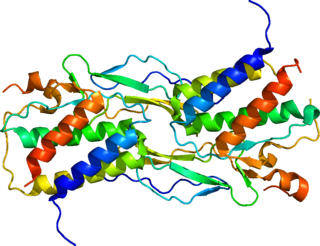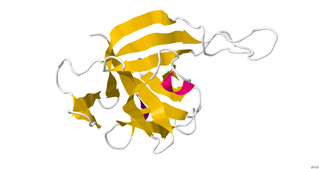Related Research Articles

The T helper cells (Th cells), also known as CD4+ cells or CD4-positive cells, are a type of T cell that play an important role in the adaptive immune system. They aid the activity of other immune cells by releasing cytokines. They are considered essential in B cell antibody class switching, breaking cross-tolerance in dendritic cells, in the activation and growth of cytotoxic T cells, and in maximizing bactericidal activity of phagocytes such as macrophages and neutrophils. CD4+ cells are mature Th cells that express the surface protein CD4.
Cell-mediated immunity is an immune response that does not involve antibodies. Rather, cell-mediated immunity is the activation of phagocytes, antigen-specific cytotoxic T-lymphocytes, and the release of various cytokines in response to an antigen.
Interleukins (ILs) are a group of cytokines that are expressed and secreted by white blood cells (leukocytes) as well as some other body cells. The human genome encodes more than 50 interleukins and related proteins.

Interleukin-15 (IL-15) is a cytokine with structural similarity to Interleukin-2 (IL-2). Like IL-2, IL-15 binds to and signals through a complex composed of IL-2/IL-15 receptor beta chain (CD122) and the common gamma chain. IL-15 is secreted by mononuclear phagocytes following infection by virus(es). This cytokine induces the proliferation of natural killer cells, i.e. cells of the innate immune system whose principal role is to kill virally infected cells.

Interleukin 33 (IL-33) is a protein that in humans is encoded by the IL33 gene.

Interleukin-26 (IL-26) is a protein that in humans is encoded by the IL26 gene.

Interleukin-25 (IL-25) – also known as interleukin-17E (IL-17E) – is a protein that in humans is encoded by the IL25 gene on chromosome 14. IL-25 was discovered in 2001 and is made up of 177 amino acids.

Interleukin-22 (IL-22) is protein that in humans is encoded by the IL22 gene.
Type II cytokine receptors, also commonly known as class II cytokine receptors, are transmembrane proteins that are expressed on the surface of certain cells. They bind and respond to a select group of cytokines including interferon type I, interferon type II, interferon type III. and members of the interleukin-10 family These receptors are characterized by the lack of a WSXWS motif which differentiates them from type I cytokine receptors.
T helper 17 cells (Th17) are a subset of pro-inflammatory T helper cells defined by their production of interleukin 17 (IL-17). They are related to T regulatory cells and the signals that cause Th17s to differentiate actually inhibit Treg differentiation. However, Th17s are developmentally distinct from Th1 and Th2 lineages. Th17 cells play an important role in maintaining mucosal barriers and contributing to pathogen clearance at mucosal surfaces; such protective and non-pathogenic Th17 cells have been termed as Treg17 cells.
Interleukin-28 receptor is a type II cytokine receptor found largely in epithelial cells. It binds type 3 interferons, interleukin-28 A, Interleukin-28B, interleukin 29 and interferon lambda 4. It consists of an α chain and shares a common β subunit with the interleukin-10 receptor. Binding to the interleukin-28 receptor, which is restricted to select cell types, is important for fighting infection. Binding of the type 3 interferons to the receptor results in activation of the JAK/STAT signaling pathway.

Interleukin-17A is a protein that in humans is encoded by the IL17A gene. In rodents, IL-17A used to be referred to as CTLA8, after the similarity with a viral gene.

Mucosal immunology is the study of immune system responses that occur at mucosal membranes of the intestines, the urogenital tract, and the respiratory system. The mucous membranes are in constant contact with microorganisms, food, and inhaled antigens. In healthy states, the mucosal immune system protects the organism against infectious pathogens and maintains a tolerance towards non-harmful commensal microbes and benign environmental substances. Disruption of this balance between tolerance and deprivation of pathogens can lead to pathological conditions such as food allergies, irritable bowel syndrome, susceptibility to infections, and more.

The Interleukin-1 family is a group of 11 cytokines that plays a central role in the regulation of immune and inflammatory responses to infections or sterile insults.

Interleukin 1 receptor-like 1, also known as IL1RL1 and ST2, is a protein that in humans is encoded by the IL1RL1 gene.

Interleukin 23 (IL-23) is a heterodimeric cytokine composed of an IL-12B (IL-12p40) subunit and an IL-23A (IL-23p19) subunit. IL-23 is part of the IL-12 family of cytokines. The functional receptor for IL-23 consists of a heterodimer between IL-12Rβ1 and IL-23R.
Innate lymphoid cells (ILCs) are the most recently discovered family of innate immune cells, derived from common lymphoid progenitors (CLPs). In response to pathogenic tissue damage, ILCs contribute to immunity via the secretion of signalling molecules, and the regulation of both innate and adaptive immune cells. ILCs are primarily tissue resident cells, found in both lymphoid, and non- lymphoid tissues, and rarely in the blood. They are particularly abundant at mucosal surfaces, playing a key role in mucosal immunity and homeostasis. Characteristics allowing their differentiation from other immune cells include the regular lymphoid morphology, absence of rearranged antigen receptors found on T cells and B cells, and phenotypic markers usually present on myeloid or dendritic cells.

ILC2 cells, or type 2 innate lymphoid cells are a type of innate lymphoid cell. Not to be confused with the ILC. They are derived from common lymphoid progenitor and belong to the lymphoid lineage. These cells lack antigen specific B or T cell receptor because of the lack of recombination activating gene. ILC2s produce type 2 cytokines and are involved in responses to helminths, allergens, some viruses, such as influenza virus and cancer.

Andrew Neil James McKenzie is a molecular biologist and group leader in the Medical Research Council (MRC) Laboratory of Molecular Biology (LMB).

Type 3 innate lymphoid cells (ILC3) are immune cells from the lymphoid lineage that are part of the innate immune system. These cells participate in innate mechanisms on mucous membranes, contributing to tissue homeostasis, host-commensal mutualism and pathogen clearance. They are part of a heterogeneous group of innate lymphoid cells, which is traditionally divided into three subsets based on their expression of master transcription factors as well as secreted effector cytokines - ILC1, ILC2 and ILC3.
References
- 1 2 3 Neill, DR; Wong, SH; Bellosi, A; Flynn, RJ; Daly, M; Langford, TK; Bucks, C; Kane, CM; Fallon, PG; Pannell, R; Jolin, HE; McKenzie, AN (2010). "Nuocytes represent a new innate effector leukocyte that mediates type-2 immunity". Nature . 464 (7293): 1367–70. Bibcode:2010Natur.464.1367N. doi:10.1038/nature08900. PMC 2862165 . PMID 20200518.
- ↑ Mirchandani, A; Salmond, R; Liew, F (2012). "Interleukin-33 and the function of innate lymphoid cells". Trends in Immunology. 33 (8): 389–396. doi:10.1016/j.it.2012.04.005. PMID 22609147.
- ↑ Camelo, A; Barlow, JL; Drynan, LF; Neill, DR; Ballantyne, SJ; Wong, SH; Pannell, R; Gao, W; Wrigley, K; Sprenkle, J; McKenzie, AN (2012-04-27). "Blocking IL-25 signalling protects against gut inflammation in a type-2 model of colitis by suppressing nuocyte and NKT derived IL-13". Journal of Gastroenterology. 47 (11): 1198–211. doi:10.1007/s00535-012-0591-2. PMC 3501170 . PMID 22539101.
- ↑ Barlow, JL; Bellosi, A; Hardman, CS; Drynan, LF; Wong, SH; Cruickshank, JP; McKenzie, AN (Jan 2012). "Innate IL-13-producing nuocytes arise during allergic lung inflammation and contribute to airways hyperreactivity". The Journal of Allergy and Clinical Immunology. 129 (1): 191–8.e1–4. doi:10.1016/j.jaci.2011.09.041. PMID 22079492.
- ↑ Moro, K; Yamada, T; Tanabe, M; Takeuchi, T; Ikawa, T; Kawamoto, H; Furusawa, J; Ohtani, M; Fujii, H; Koyasu, S (2010-01-28). "Innate production of T(H)2 cytokines by adipose tissue-associated c-Kit(+)Sca-1(+) lymphoid cells". Nature. 463 (7280): 540–4. doi:10.1038/nature08636. PMID 20023630. S2CID 4420895.
- ↑ Price, AE; Liang, HE; Sullivan, BM; Reinhardt, RL; Eisley, CJ; Erle, DJ; Locksley, RM (2010-06-22). "Systemically dispersed innate IL-13-expressing cells in type 2 immunity". Proceedings of the National Academy of Sciences of the United States of America. 107 (25): 11489–94. Bibcode:2010PNAS..10711489P. doi: 10.1073/pnas.1003988107 . PMC 2895098 . PMID 20534524.
- 1 2 Saenz, SA; Siracusa, MC; Perrigoue, JG; Spencer, SP; Urban JF Jr; Tocker, JE; Budelsky, AL; Kleinschek, MA; Kastelein, RA; Kambayashi, T; Bhandoola, A; Artis, D (2010-04-29). "IL25 elicits a multipotent progenitor cell population that promotes T(H)2 cytokine responses". Nature. 464 (7293): 1362–6. Bibcode:2010Natur.464.1362S. doi:10.1038/nature08901. PMC 2861732 . PMID 20200520.
- ↑ Neill, DR; McKenzie, AN (May 2011). "Nuocytes and beyond: new insights into helminth expulsion". Trends in Parasitology. 27 (5): 214–21. doi:10.1016/j.pt.2011.01.001. PMID 21292555.
- ↑ Saenz, SA; Noti, M; Artis, D (Nov 2010). "Innate immune cell populations function as initiators and effectors in Th2 cytokine responses". Trends in Immunology. 31 (11): 407–13. doi:10.1016/j.it.2010.09.001. PMID 20951092.
- ↑ Wong, SH; Walker, JA; Jolin, HE; Drynan, LF; Hams, E; Camelo, A; Barlow, JL; Neill, DR; Panova, V; Koch, U; Radtke, F; Hardman, CS; Hwang, YY; Fallon, PG; McKenzie, AN (2012-01-22). "Transcription factor RORα is critical for nuocyte development". Nature Immunology. 13 (3): 229–36. doi:10.1038/ni.2208. PMC 3343633 . PMID 22267218.